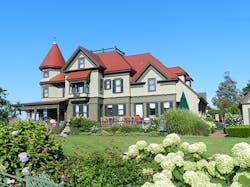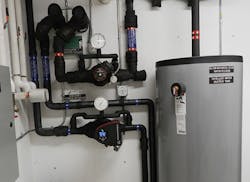OAK BLUFFS, MASS. — The Norton Residence is the most famous house on Martha's Vineyard. Built in 1891 by Philip Corbin, manufacturing tycoon, it was the most extravagant summer mansion in the town of Oak Bluffs on Martha's Vineyard.
After 100 years of neglect, it was bought in 1991 by Peter Norton, the computer software pioneer, and carefully restored to its former glory through a meticulous restoration.
During a fierce winter storm in February of 2001, the home burned to the ground due to an electrical fire. It was then completely rebuilt in 2006 as an exact replica of the original home with the addition of air conditioning.
Unfortunately, though the house itself was gorgeous inside and out, the indoor comfort was consistently compromised by the inadequate air conditioning system. Finally, this year, Nelson Mechanical Design, Inc. was called in to resolve the A/C woes: the system did not adequately cool the house, several compressors had failed, the system was constantly flooding (several leaks through the paneled wood ceilings) and the home was often clammy and humid.
The existing air conditioning system was built around an outside 10 ton MultiAqua air-to-water chiller that sent chilled water to four air handlers inside the home.
Problems with existing installation
Unfortunately, ¾-in. copper pipe had been used for all of the chilled water piping, so all of the air handlers were getting only half of the required water flow through their coils.
In addition to this starvation of the inside coils, the outside chiller was not getting its necessary design water flow either, thus leading to overheating and ultimately the failure of the two outside chillers’ compressors.
Nelson Mechanical relies on innovative system for Martha's Vineyard residence
Nelson Mechanical Design swoops in for geothermal system rescue
In addition, the manufacturer of the chiller required at least 50 gallons of water in the system, but the current system had only 25 gallons; this led to excessive on/off cycling of the outside compressors.
At the center of these issues was the use of a single undersized circulator in the entire system to try to meet the flow requirements of all of the equipment. This led to a serious mismatch between the cooling output of the outside chiller and the cooling needs of the house.
Uncontrolled operation
The existing circulator mindlessly sent chilled water to the four air handlers in the house 24 hours a day for the entire cooling season. It didn't know if the house needed cooling or not.
Likewise, the outside chiller didn't know if the house needed cooling or not either — it just mindlessly ran to keep the chilled water at 48°F all summer long, all the time. In addition, without a buffer tank to smooth out the difference between the house's cooling requirements and the outside chiller's capacity, for most of the summer the chiller was vastly oversized for the cooling load.
This led to very inefficient operation, way too many start and stop cycles of the outside chiller, reduced reliability, increased wear and tear, reduced comfort and little or no dehumidification.
The retrofit
To resolve these issues Nelson Mechanical installed motorized ball valves, balancing valves, a buffer tank and a pressure sensing circulator. On the four air handlers (three in the attic and one in the basement) Belimo motorized ball valves were installed, giving complete control of the flow of chilled water without any water hammer or noise.
Also installed were Victaulic balancing valves that determine and set the chilled water flow through each air handler — no more and no less than required.
In the basement a 120 gallon buffer tank was installed — this met the outside chiller's requirement of a MINIMUM of 50 gallons of water in the system. This greatly reduced the wear and tear on the compressors and "decoupled" the house cooling load from the outside chiller — no more mismatch between outside chiller and inside cooling load.
The existing single circulator was connected to the outside chiller to the buffer tank. This ensured there was the required minimum flow through the outside unit.
Now the outside chiller would be nicely matched with what it thought was a large cooling load (actually just the new buffer tank). The result would be much less frequent stops and starts resulting in much higher efficiency and lifespan of the chiller compressors.
Below this dedicated chiller circulator a new Grundfos Magna3 pressure sensing circulator was installed. This circulator connected the new buffer tank with the four air handlers through the existing piping. It was set it up in pressure sensing mode with a constant pressure set point, which was derived from installers educated guess of the pressure drop through the existing ¾-in. copper supply and return lines, the pressure drop through the new motorized ball valves, the balancing valves, and the air handler chilled water coils.
New control system
A Distech DDC controller was chosen to operate the control scheme: when there was a call for cooling the air handler for that zone would start its blower and start to open the motorized ball valve. The end switch on the ball valve would turn on the Magna 3 in the basement. The Magna 3 would see that there was a drop in pressure of the chilled water system and it would gradually speed up to reach its pressure set point (resulting in the correct water flow through the chilled water coil of that air handler).
If other zones called for cooling, their blowers would start and motorized ball valves would open and the system pressure would drop again — the Magna 3 would see this and speed up some more — pumping more chilled water from the buffer tank to each air handler needing chilled water.
Likewise, as each zone was satisfied and there was no need for cooling in that zone, the air handler's motorized ball valve would close, the chilled water pressure would start to rise, and the Magna 3 circulator in the basement would start to slow down and reduce the pressure of the chilled water.
This "smart" pressure sensing circulator would end up pumping only the exact amount of chilled water needed by the air handlers when they need it — no more 24/7 pumping of chilled water. The end result was consistent A/C comfort throughout the home all summer long.
Brian Nelson is a Master Plumber and Master Sheet Metal license holder and is working towards his Certified Geothermal Designer license, and has a Master's Degree in Mechanical Engineering. He is a member of ASHRAE and writes regularly for national trade publications about renewable energy projects.
About the Author
Brian Nelson
Brian Nelson is the co-owner of Nelson Mechanical Design, a “green” mechanical contractor serving the energy efficiency and home comfort needs of Martha's Vineyard, MA since 2004. The company designs, installs, and services just about anything to do with heating, cooling, domestic hot water, water treatment, geothermal, heat pumps, and radiant. NMD is committed to preserving the fabric of the Island it calls home. To learn more visit nmdgreen.com.


